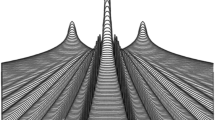Abstract
For Metropolis Monte Carlo simulations in statistical physics, efficient, easy- to-implement, and unbiased statistical estimators of thermodynamic properties are based on the transition dynamics. Using an Ising model example, we demonstrate (problem-specific) variance reductions compared to conventional histogram estimators. A proof of variance reduction in a microstate limit is presented.
Similar content being viewed by others
REFERENCES
N. Metropolis, A. Rosenbluth, M. Rosenbluth, A. Teller, and E. Teller, Equations of state calculations by fast computing machines, J. Chem. Phys. 22:1087–1092 (1953).
M. Fitzgerald, R. R. Picard, and R. N. Silver, Canonical transition probabilities for adaptive Metropolis simulation, Europhys. Lett. 46:282–287 (1999).
S. Chib and E. Greenberg, Understanding the Metropolis-Hastings algorithm, American Statistician 49:327–335 (1995).
A. M. Ferrenberg, D. P. Landau, and R. H. Swendsen, Statistical errors in histogram reweighting, Phys. Rev. E 51:5092–5100 (1995).
G. R. Smith and A. D. Bruce, A study of the multicanonical Monte Carlo method, J. Phys. A: Math. Gen. 28:6623–6643 (1995).
E. Anderson et al., SIAM (1994). [http://www.netlib.org/lapack/lug/lapack/lug.html].
J. S. Wang, T. K. Tay, and R. H. Swendsen, Transition matrix Monte Carlo reweighting and dynamics, Phys. Rev. Lett. 82:476–479 (1999).
P. M. C. de Oliveira, T. J. P. Penna, and H. J. Herrmann, Broad histogram Monte Carlo, Eur. Phys. J. B 1:205–208 (1998).
P. D. Beale, Exact distribution of energies in the two-dimensional Ising model, Phys. Rev. Lett. 76:78–81 (1996).
B. A. Berg and T. Neuhaus, Multicanonical ensemble: A new approach to simulate first-order phase transitions, Phys. Rev. Lett. 68:9–12 (1992).
W. Feller, An Introduction to Probability Theory and Its Application, Vols. 1 and 2 (Wiley, New York, 1971).
P. H. Peskun, Optimum Monte Carlo sampling using Markov chains, Biometrika 60:607–612 (1973).
V. I. Romanovsky, Discrete Markov Chains (Wolters-Noordhoff, Groningen, Netherlands, 1970).
C. R. Rao, Linear Statistical Inference and Its Applications (Wiley, New York, 1973).
Author information
Authors and Affiliations
Rights and permissions
About this article
Cite this article
Fitzgerald, M., Picard, R.R. & Silver, R.N. Monte Carlo Transition Dynamics and Variance Reduction. Journal of Statistical Physics 98, 321–345 (2000). https://doi.org/10.1023/A:1018635108073
Issue Date:
DOI: https://doi.org/10.1023/A:1018635108073




